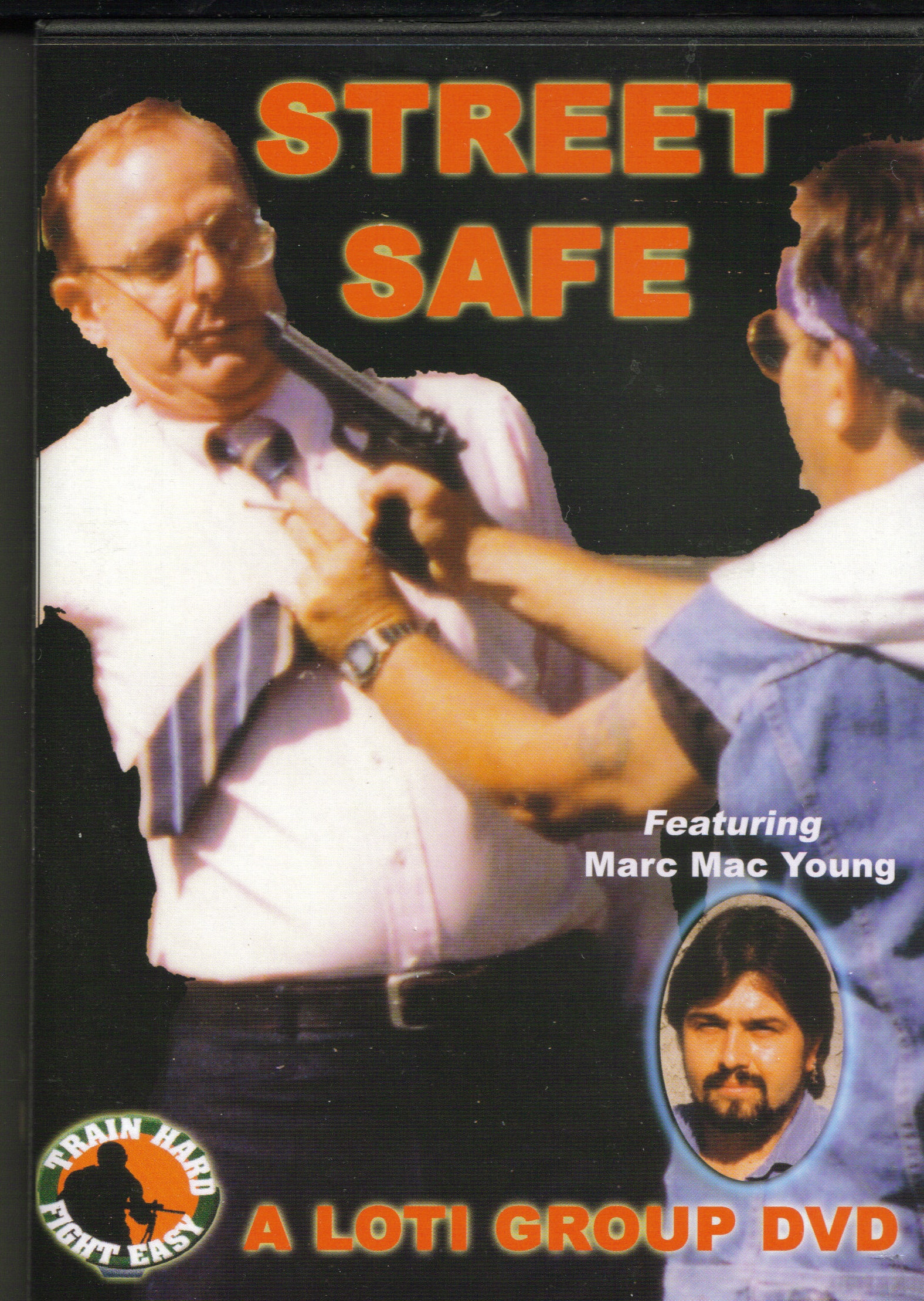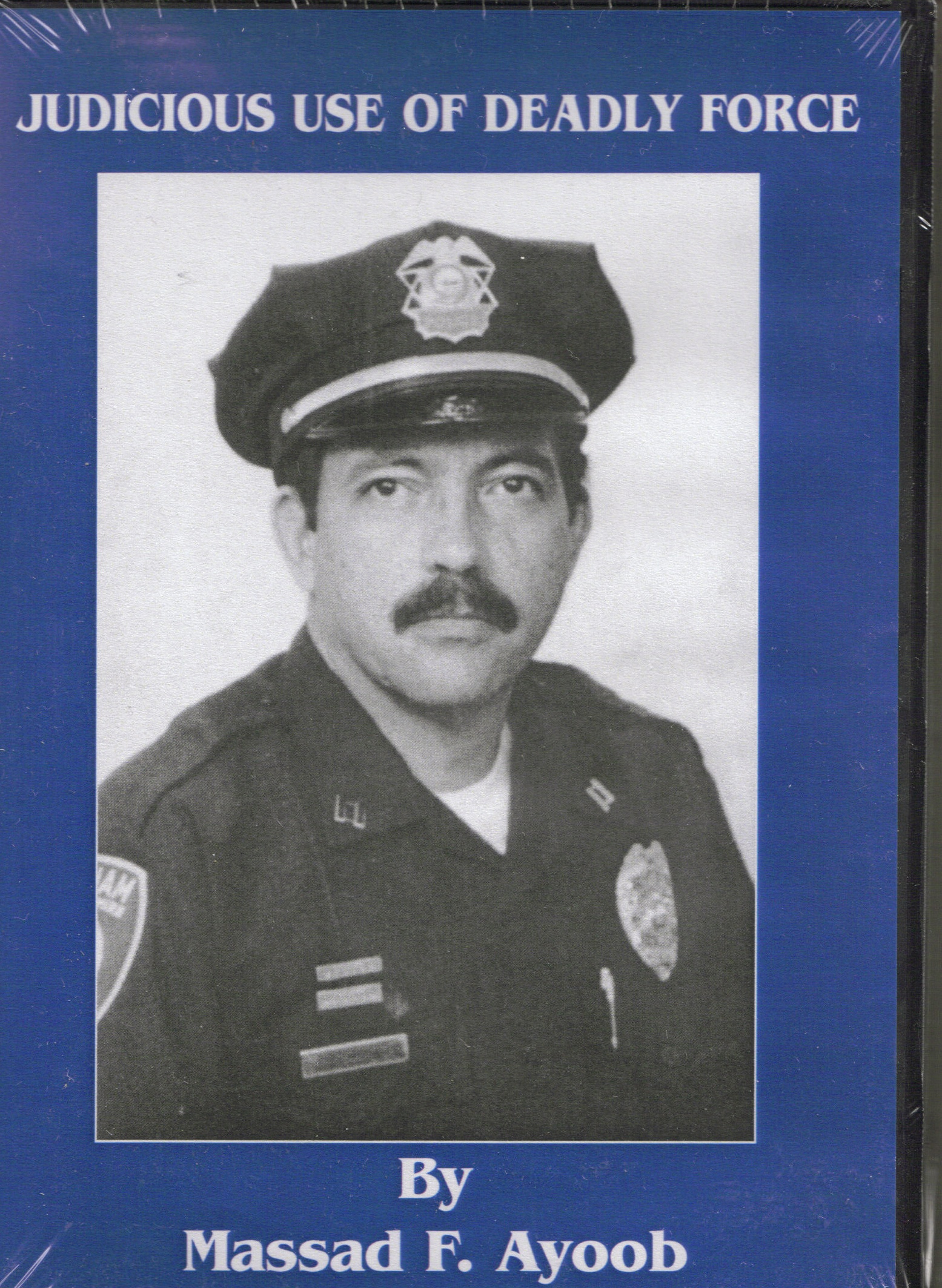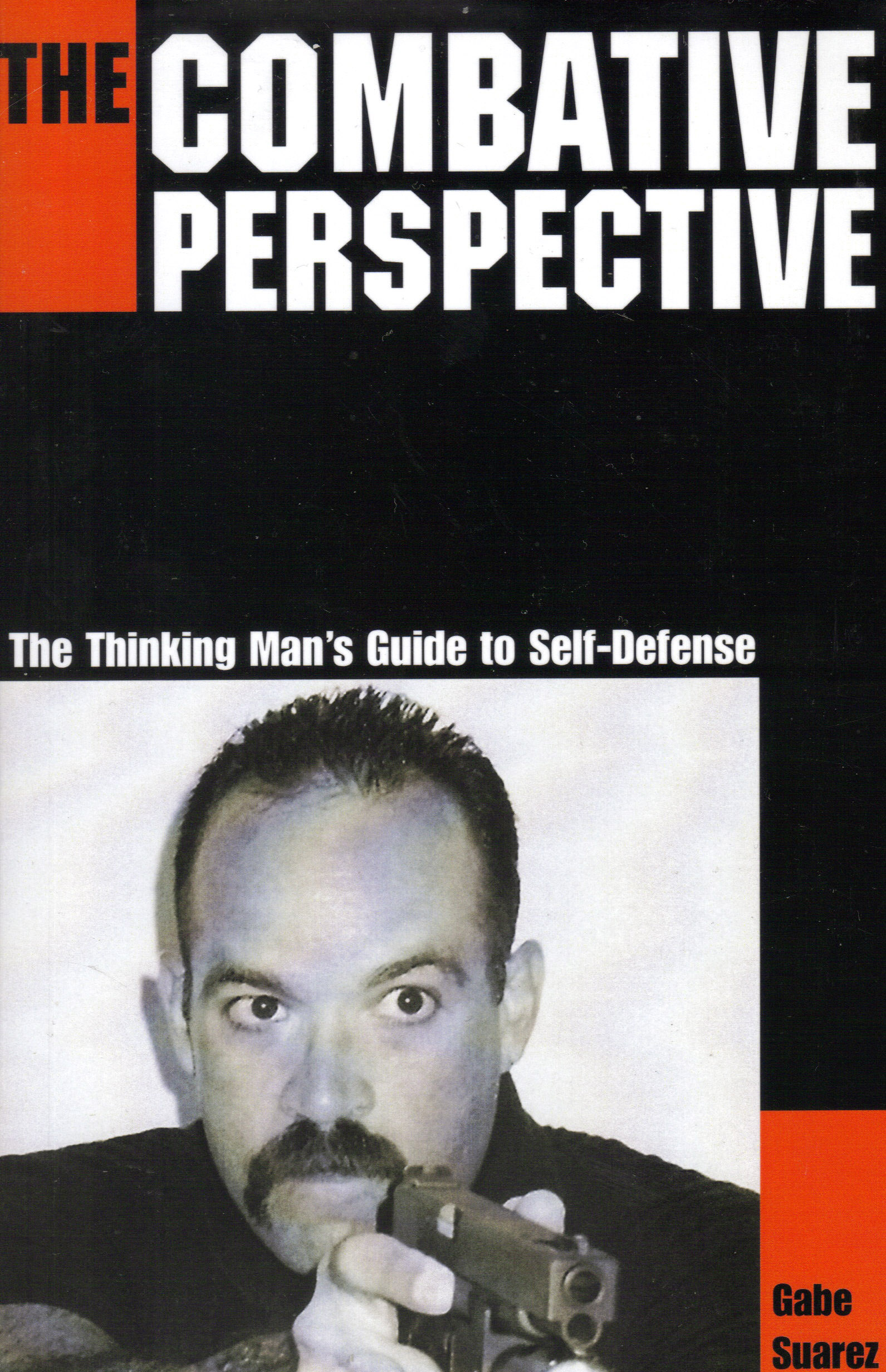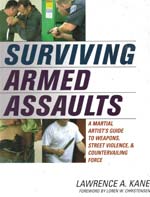Marc MacYoung?
Dianna Gordon MacYoung?
Animal E-list
Crime Avoidance Lectures
Crime Blog
Colorado Classes
Contact Us
FAQs
Hosting A Seminar
Crime Prevention
Expert Witness
Knife Defense
Law Enforcement
Martial Arts
Military
Movie Consulting
Women's Self-Defense
Links
Our Linking Policy
On-line Store
Train with MacYoung
Testimonials
Terms of Use
Topics
of Interest
Self defense isn't about empowerment, personal
gain, winning,
revenge or teaching those who have hurt you a lesson.
Those
are the motivations of an attacker. Self-defense is
about effectively
ending an attack, quickly and with minimum damage to
yourself.
Marc MacYoung
A different perspective on self-defense training
On this page:
Why this approach? |
What needs to be in "self-defense" training |
Four tiers of self-defense training |
Why must these be included? |
Judging a good self-defense program
In order to understand what "self-defense" is, you must first understand what it is not. "Self-defense" is not martial arts training. Nor is it fighting. It is not getting in touch with your inner rage and channeling it into attacking someone who scared you. It is not simply mastering a set of physical skills (e.g. becoming a kung fu killer ninja or combat shooting expert). Nor is it something you can take a weekend seminar for and then forget until you need it.
In our definition, self-defense is not a *specialized* skill that you only use in one context. In our definition it is part of a much large set of "life skills."
These are skills, talents and abilities that you will use in a myriad of ways every day of your life. What's more, as they are basic "people skills" using them will improve your quality of life. Use them and you will find yourself in far fewer conflicts, you will be more popular, work will be easier and you will get along with people much, much better.
All "self-defense" is is taking these same skill sets and applying them in a slightly different context. To a large degree, they are the same skills with some slight "tweaks." Properly applied, you will never have to use physical force to protect yourself because you will learn to steer yourself clear from situations where violence is likely.
To give you a slightly different perspective Peyton Quinn, in his excellent book Freedom from Fear, describes it thusly "Self-defense is the art of dealing with predators -- exploitive , hostile or abusive people. As we have seen they can be found in any sphere of our lives; in the streets, in the office, at home and even in intimate relations. Consequently when I use the term 'self-defense I am not just talking about defending yourself against a person who wants to beat you up, kill, rob or rape you. Even so, do not dismiss the reality that you may be forced to deal with physical violence."
Even though we use 'self-defense' differently than Peyton, the general idea is the same. And that is there is much more to self-defense and personal safety than just physical technique.
Why do we take this approach?
Violence is an extreme. What people don't tend to recognize about extremes is
that they don't just "happen." It takes time and effort to make such a long
journey to this wild place. Putting bluntly, you have to work to get there.
Furthermore, extremes are based in taking normal interactions, over-emphasizing certain elements and intentionally deleting other -- tempering -- influences. What that means is that any extreme is based on that which you already know. It is just taken and blown out of proportion. It is so distorted however, that you may not recognize it as such -- especially the part about tempering influences being left out. There are several common reasons for this failure, the most common ones are anger, emotion or stubbornness on your part. These don't have to be regular states with you either, giving in to them just for a moment can put you on the path towards violence. Lose control of yourself with the wrong person and you will be shot, stabbed, beaten or raped.
The "trick" for avoiding violence is recognizing what it is -- and the path that leads there.
By knowing the elements that are commonly used in this extreme -- and what their normal proportions are -- you will be able to see when they are being blown out of proportion. It takes time to get to an extreme, when you see these elements being distorted -- even by yourself -- you will know you are on the pathway to violence.
Our approach is to acquaint you with these elements so you can recognize this distortion -- and its significance -- early enough that you can extract yourself from a situation without having to resort to physical violence. It is far, far easier to stop, take a deep breath, turn and walk away than it is to physically combat your way out of an attack -- especially if weapons are involved.
Trust us on this one, we have the scars to prove it.
What needs to be included in "self-defense" training
In martial arts training you can find depths far beyond the physical. There are
many useful skills and attributes one can acquire through their study.
Realistically, martial arts are like a large pool, you can go as deep or as
shallow as you wish. That means you can safely focus on whatever
particular aspect you find most fascinating. Simply stated martial arts can
be as deep, rich and fulfilling or as shallow and one-dimensional as you want it
to be.
However, in order for self-defense training to be effective, it must be multi-layer.
By this we mean that a wide variety of skill-sets, knowledge, self-awareness and behaviors are involved. Many, that at first glance, might not be obviously related to what you think of as "self-defense." But each adds an important layer onto the whole of the subject, and therefore, your safety. As such you must consciously focus on all of these layers if you wish to be save from violence.
Four tiers of self-defense training
The following model was given to us by Justin Kocher, 2nd Dan in Danzan Ryu
Jujitsu (Westside
DRJ Los Angeles). He developed this summation after many long hours of
discussing, researching, training, teaching and wrestling with the problem of
communicating the issues involved in self-defense. It is a simple and elegant
model for explaining what we mean by "effective self-defense training must be
multi-layered."
As you can see the issues become larger and more complex the further away one gets from just the physical. A critical issue is that many so-called "self-defense" courses/martial arts schools do not address these "higher" level skills because they assume they already are in place. We do not. We have seen countless incidents of violence that could have been avoided if they had been.
Why must these layers be included?
There are several reasons.
First, You cannot focus on only one aspect and expect your "self-defense" to work. For example, physical application is the most basic and simplest skill set. It is also the last ditch, extreme response. If a situation goes physical it generally means you have not applied the other skill sets correctly. You have allowed the situation to develop to an extreme. Unfortunately, physical force is also the most unreliable of responses. And, as you are now in an extreme, if it fails, you are in deep trouble. It is literally jumping out of a plane with only one parachute that has a 50/50 chance of not working..
The multi-layer approach is back-up. To be more specific it is having options that prevent you from ending up in that situation. Including, not going parachute jumping in the first place, but if you do, knowing how to pack your chute so it will open. By having these layers, you have control and influence anywhere along the process. It is also knowing the further down that path you go, the more extreme the danger and the more likely you are to lose control of the situation.
Second, there is commonly an underlying assumption of self-righteousness regarding so-called "self-defense." In fact, some programs go so far to encourage fighting while still others encourage behavior that will commonly lead to violence. To begin with there is a drastic difference between self-defense and fighting and it is a difference that you need to know. Bottom line, it will not be immediately apparent to the responding officer that you are the "victim" who was obviously only defending him/herself against this horrible person. While police will often arrest both parties in a "fight" they are almost guaranteed to arrest the "winner." If you have successfully "defended" yourself, then that means you. Furthermore, your claim of "self-defense" is going to be seriously undermined if you were an equal participant in the problem -- no matter how self-righteous or justified you felt you were. As there are serious legal ramifications to this subject you had better make sure that you weren't part of the problem.
Third, the effects of violence will last a life time. It doesn't matter if you are the victim, the perpetrator or even if you were just defending yourself, exposure to, and participation in violence, will change you. Often, not for the better.
In the long run, these higher levels will give you the coping skills necessary to deal with the changes violence will cause. Your entire life is a long time to justify or self-righteously put the blame on another. It requires more work than many people are capable of doing. In other words, while in the short run self-righteousness and anger can protect you, over time guilt, shame, moral pain and trauma over what you did will eventually creep in.
In the immediate, these levels will help you get through the emotional/adrenaline stressors that come with having to defend yourself. Contrary to popular belief, an overwhelming majority people cannot just "flip an emotional switch" and find *and* apply effective self-defense moves in a crisis. Combat is a traumatic psychic "shift." One, that if you do not have specific training to prepare you for, you might not be able to make in time to defend yourself.
Fourth, they remove doubt. If you have established, external standards by which to judge when you are legally and morally justified to use violence in your defense then you will be able to act with grim, un-conflicted determination towards achieving the goal. This is not an emotional or subjective reaction, it is reacting to a known and identified threat.
The fifth reason relates back to both the second and fourth reasons, but is a distinct enough to be its own reason. The fifth is that by knowing these other issues, you will greatly assist yourself in communicating with the police and defending your actions in a court of law as to "why" you felt it was necessary to use physical force. Violence doesn't happen in a vacuum, legal repercussions are as much of a danger as the physical assault. This is why you need to understand that aspect and how to survive the court battle as well as the violent encounter. If you cannot articulate "why" you felt it necessary to use physical force, the authorities it will turn into a "your word against his". Unfortunately, as he is now "injured" the weight of the argument is on his side. That in the eyes of the law makes you the aggressor (read: the guilty party).
Also never underestimate how an attorney can turn your words against you. You might have been utterly and totally correct in your assessment that physical force was required to protect yourself. However, if you cannot supply "articulatable facts" that list A) his behavior according to established, external standards of "jeopardy" behavior and B) what you did to de-escalate/avoid the altercation, an attorney will twist you around like a pretzel on the stand. He will turn your "self-defense pleas into have you babbling about "well he looked at me mean!" as to why you put his "poor innocent client" in the hospital. After he has ripped your self-defense stance apart, he will make you look like the person who intentionally started the violence.
The sixth reason is that the higher levels instill in you negotiating skills and conflict avoidance. This doesn't mean that you run like a rabbit. It simply means that you have a wider set of tools at your disposal to find ways to resolve potential conflicts and problems without resorting to extreme measures. These are what are known as people skills. The better you become at them, the less likely you are to find yourself in a violent situation. Avoiding violence is the very least these skills can do for you. More realistically they will dramatically improve the quality of your life. At home, work and in your social life, you will achieve more of your goals with less conflict and stress.
Judging a good self-defense program
We maintain that the way to judge *effective* self-defense training for the
"average person" is that a MAJORITY of the class needs to focus on issues other
than the physical. The physical is only one small layer of skill sets.
This is simply not realistic. A point we feel strongly about is that effective self-defense training focuses as much on your responsibility for your words/actions and the legal restrictions/repercussions of violence as it does your "right" to hit. A set of standards that you will find missing from much of so-called self-defense training can be found at Brandon Otto's Introduction to Use of Force page.
As stated earlier, apparently most self-defense instruction (at least all the ones we have encountered) assume that these other layers and skill sets are already in place, In doing so, they ignore addressing the issues that lead up to physical violence. Without hesitation or safety warnings, some of these programs teach extreme physical violence and often lethal force. Another common short coming in "self-defense" programs is the assumption that having these skill sets is someone else's responsibility -- and that "somebody" is other than the student. It's up to other people to have all the self-control, empathy and people skills. These classes approach conflict from a very biased, blaming standpoint (i.e. "it is all the other guy's fault and whatever you do is justified"). A very important buzzword to watch for in such programs is "empowerment." A program that is focused on "empowering" someone, many times gives a a "carte blanche" excuse for the behaviors and attitudes that result in conflict and violence.
Simply stated, any program that give you the idea you that you are justified in doing or saying anything you want and that the training will teach you how to fight if someone takes umbrage, isn't teaching self-defense. It is at best encouraging and reinforcing dysfunctional, selfish behavior and at the worst setting you up to get your brains blown into a fine pink mist if you behave that way towards a truly violent and dangerous person..
The issues about behaviors that lead up to violence are of major import and should not be given lip-service or merely a passing nod while rushing off to learn how to hit someone. While it is obvious that you cannot get a full explanation of all the aspects of every level from a two-day seminar, such programs should at least introduce you to the concepts involve. Also they need to be able to give you an indication where to do further research on your own.
As an extra benefit for instructors of self-defense, you might want to visit the WIMs page. This page addresses a very common problem that self-defense instructors face, the dreaded What If Monkey.



Street Safe: How to
Recognize and Avoid Violent Crime
Learn More >
Order Now!

Safe in the City
Learn More >
Order Now!

The Missing Link: Self-Protection Through Awareness,
Avoidance and De-Escalation
Learn More >
Order Now!

Escape Combatives
Special Bonus Feature
ESCAPE DRIVING
Learn More >
Order Now!

In the Gravest Extreme
Learn More >
Order Now!

Judicious
Use of Deadly Force
Learn More >
Order Now!

Affordable Security
Learn More >
Order Now!

Cheap Shots, Ambushes and Other Lessons
Learn More >
Order Now!

Violence, Blunders And Fractured Jaws: Advanced
Awareness, Avoidance and Street Etiquette
Learn More >
Order Now!

Real World Self-Defense
Learn More >
Order Now!

Experience- & Reality-Based Self-Defense
Learn More >
Order Now!

Fighting Dirty
Learn More >
Order Now!

The Combat Perspective: A Thinking Man's Guide
to
Self-Defense
Learn More >
Order Now!

Street Smarts, Firearms and Personal Security
Learn More >
Order Now!

Surviving a Street Knife Attack
Learn More >
Order Now!

Post Shooting Trauma
Learn More >
Order Now!

CQB Clearing Tactics For First Responders/ Patrol Tactics for 911 Officer
Learn More >
Order Now!

Surviving Workplace Violence
Learn More >
Order Now!

Surviving Armed Assaults
Learn More >
Order Now!
Defeating The Victim's Consciousness
| About navigating this site | Animal List | Bibliography | Bullies | Burglary while on vacation | Classes in Colorado | Car Jacking | Children and Martial Arts | Child Safety | Criminal Mindset | Cults in MA/SD | De-Escalation | E-mail Dianna | E-mail Marc| FAQs | Have MacYoung speak about crime avoidance | Home Page | Home Defense | Hosting a Seminar | Fear | Five Stages of Crime | Knife Fighting | Legal Issues | LEO/Correctional Officer/EMS | Linking policy | Links | Martial Arts | Photo Gallery | Property Crime | Psychology | Rape | Robbery | Safe Dating | Self-Defense Training | Selling your books/DVDs on NNSD | Seminar Schedule | Stalking/Domestic Violence | Street Fighting | Terms of Use | Testimonials | Train with Marc MacYoung | Who is Dianna Gordon MacYoung? | Who is Marc "Animal" MacYoung? | Victimhood | Workplace Problems | Zero Tolerance | ||
| ? 1998-2008 No Nonsense Self-Defense, LLC. All rights reserved. |